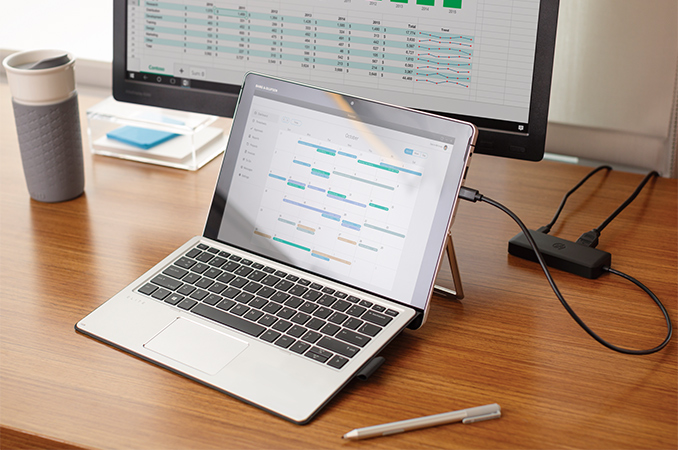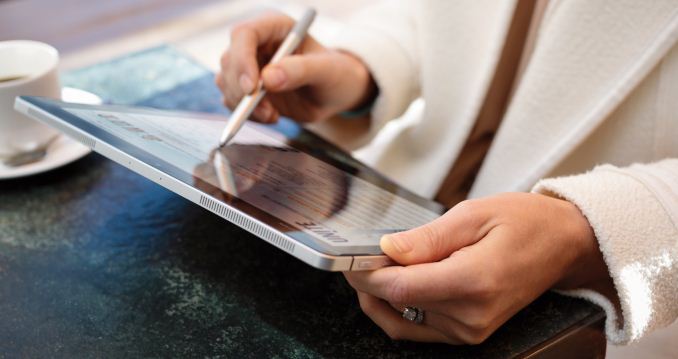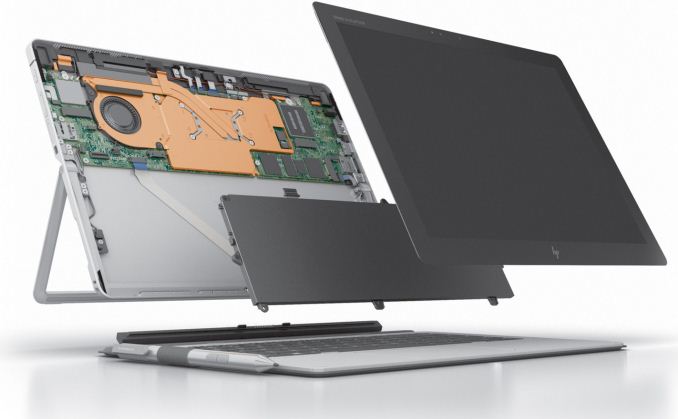HP Launches Elite x2 1012 G2 2-in-1: 12.3-Inch Display, Kaby Lake, 1 TB SSD, 16 GB LPDDR3, TB3
by Anton Shilov on May 19, 2017 9:00 AM EST
HP has announced the second generation of its Elite x2 1012 2-in-1 detachable PC designed for commercial applications. The next-gen system not only gets more powerful Kaby Lake SoCs, but has also seen improvements across the board compared to its predecessor: it now has a larger display with a higher resolution and brightness, two times more DRAM, up to a 1 TB SSD, Thunderbolt 3, a higher-capacity battery, enhanced security features, and other advancements. Despite all the upgrades, HP has managed to maintain thin profile and low weight of the Elite x2 1012 G1.
When it comes to Elite x2 systems, HP shares the “power of a notebook, flexibility of a tablet” philosophy and acts accordingly — equipping them with powerful hardware, but minding portability and keeping the weight of the tablet itself at around 800 grams. The company is positioning the Elite x2 1012 G2 as a fully-fledged replacement for executive laptops, so the new units feature notebook-class Core i5/i7 7000U-series CPUs and can be equipped with virtually every modern technology found in mobile PCs, including 4G LTE, WiGig, a fingerprint reader, Thunderbolt 3, an audio sub-system co-developed with Harman Kardon, and so on to make them suitable for various use cases. Moreover, the Elite x2 1012 G2 can be serviced quite easily — a benefit for experienced users and IT departments.
At the same time, the Elite x2 is not designed for every possible application that is out there. For example, the systems lack smart card readers, which are required by some government agencies; they are also not equipped with NFC modules that various retailers may use. For those specific users, there's HP’s existing Pro x2, which was launched earlier this year. Furthermore, being equipped with Intel Core i5/i7-Y (KBL-Y) SoCs, the Pro x2 has no fans, whereas the Elite x2 G2 runs notebook SoCs with higher frequencies and improved iGPUs, which is why it's not a sealed system
Internally, the HP Elite x2 G2 is based on Intel’s Core i5/i7 7000U-series SoCs, which feature the Kaby Lake microarchitecture along with the HD Graphics 620 (16 EUs, Gen 9) iGPU. This is a clear improvement over the Elite x2 G1 that run SoCs with lower frequencies and with an iGPU with fewer EUs (12 EUs). The Elite x2 system comes with 16 GB of dual-channel LPDDR3 memory (not upgradeable) and an M.2 SSD with a SATA or PCIe interface and capacities ranging from 128 GB to 1 GB. When it comes to communication capabilities, the Elite x2 can be equipped with a selection of wireless controllers, from a “basic” 802.11ac 2×2 Wi-Fi + BT 4.2 controller to something more powerful with WiGig and/or 4G LTE. Among external ports, the Elite x2 G2 offers one Thunderbolt 3 (USB Type-C) header for data, charging, external displays, etc.; one USB 3.0 Type-A; a microSD slot as well as a TRRS connector for headsets.
| Specifications of the Second Generation HP Elite x2 | ||
| HP Elite x2 1012 G2 |
||
| LCD | Diagonal | 12.3" |
| Resolution | 2736×1824 | |
| Brightness | 450 cd/m² | |
| CPU | Core i7-7600U (2C/4T, 4 MB, 2.8/3.9 GHz) Core i5-7300U (2C/4T, 3 MB, 2.6/3.5 GHz) Core i5-7200U (2C/4T, 3 MB, 2.5/3.1 GHz) Core i3-7100U (2C/4T, 3 MB, 2.4 GHz) |
|
| Graphics | HD Graphics 620 (24 EUs) | |
| RAM | 16 GB LPDDR3 | |
| Storage | 128 GB M.2 SATA SSD 256 GB up to 1 TB M.2 PCIe NVMe TLC SED SSD 256 GB up to 512 GB M.2 SATA TLC SSD 360 GB M.2 PCle 3.0 x4 TLC SSD 256 GB up to 512 GB M.2 PCIe SSD 256 GB up to 512 GB M.2 PCIe SSD |
|
| Wireless: Wi-Fi, Bluetooth, LTE, GPS and WiGig options | Intel Dual Band Wireless-AC 8265 802.11ac Wi-Fi + BT 4.2 HP hs3210 WW HSPA+ Mobile Broadband HP lt4132 LTE/HSPA+ 4G Mobile Broadband Intel Tri Band Wireless-AC 18265 802.11a/b/g/n/ac (2x2) and Bluetooth 4.2 WiGig Combo HP lt4120 LTE/EV-DO/HSPA+ Mobile Broadband HP lt4226 LTE/HSPA+ Qualcomm Gobi 4G Module HP lt4225 LTE/EV-DO Qualcomm Gobi 4G Module u-blox EVA-M8M M.2 GPS module 8,9,10,11 |
|
| USB | 3.1 | 1 × TB 3 |
| 3.0 | 1 × Type-A | |
| 2.0 | - | |
| Thunderbolt | 1 × TB 3 (for charging, data, DP 1.2 displays) | |
| Card Reader | MicroSD | |
| Cameras | Front | 5 MP front-facing camera + IR camera for face authentication |
| Back | 8 MP rear-facing camera with flash LED | |
| Fingerprint Sensor | Yes | |
| Other I/O | Microphone, stereo speakers, audio jack | |
| Other Sensors | Tablet | Tablet: Accelerometer, magnetometer, gyro, ambient light sensor, proximity (SAR for WWAN) |
| Travel and Advanced Keyboard | Hall effect, dual Accelerometers |
|
| Battery | 47 Wh | |
| Thickness | 91 mm (tablet) 146 mm (with keyboard) |
|
| Weight | 800 grams (tablet) 1.15 kg (with travel keyboard) 1.33 kg (with advanced keyboard) |
|
| Price | Starting at $1099 | |
Meanwhile as the Elite x2 G2 doubles as a tablet, system is equipped with a host of sensors (accelerometer, gyroscope, magnetometer, etc.) and is compatible with styluses. It also has rather powerful imaging capabilities: on the front it has a 5 MP RGB camera coupled with an IR sensor, on the backside it features an 8 MP sensor with a LED flash. Also found on the backside is the system's fingerprint reader.
As for the chassis, the HP Elite x2 1012 G2 uses a similar — but not exactly identical — body as its predecessor. The new 2-in-1 laptop is made of aluminum; HP does not reveal the exact alloy, but it should be something durable, like the Aluminum 6061 alloy used for the Pro x2. Due to major changes of the internal architecture, the thickness of the new tablet has increased to 9.1 mm/0.36” (from 7.6 mm/0.3”), but the weight of the tablet has remained at around 800 grams/1.77 lb. Meanwhile, the display of the new Elite x2 G2 has improved significantly: the diagonal size has increased to 12.3” due to thinner bezels, its resolution has improved to 2736×1824 pixels, and the brightness is now rated for 450 nits. Corning's Gorilla Glass 4, which is used for numerous other HP products as well, protects the screen of the Elite x2 G2.
Speaking of the weight and dimensions, and given the positioning of the HP Elite x2 G2, it makes sense to compare it to ultra-thin laptops. As it appears, once the Elite x2 G2 is equipped with a keyboard, its final thickness is 14.6 mm (0.57”), which is thicker than many contemporary notebooks, especially those based on lower-power CPUs. Clearly, the HP Elite x2 G2 has multiple advantages when compared to such mobile PCs (e.g., display resolution, connectivity, higher-capacity battery, form-factor, performance, security, etc.), but the ultimate portability will not be one of them.
| Comparison of Ultra-Thin Notebooks | |||||||
| HP Elite x2 1012 G2 |
Samsung Notebook 9 |
Samsung Notebook 9 |
Dell XPS 13 | HP Spectre | Apple MacBook (2016) | ||
| LCD | Diagonal | 12.3" | 13" | 15" | 13" | 13.3" | 12" |
| Resolution | 2736×1824 | 1920×1080 | 1920×1080 3200×1800 | 1920×1080 | 2304×1440 | ||
| Brightness | 450 cd/m² | 400 ~ 500 cd/m² | unknown | 300 cd/m² | unknown | ||
| CPU | Core i7-7600U Core i5-7300U Core i5-7200U Core i3-7100U |
Core i5-7200U Core i7-7500U |
Core i7-7500U | Core i3-7100U Core i5-7200U Core i7-7500U |
Core i5-7200U Core i7-7500U |
Core m3-6Y30 Core m5-6Y54 Core m7-6Y75 |
|
| Graphics | HD Graphics 620 (24 EUs) | Intel HD Graphics 515 (24 EUs) | |||||
| RAM | 16 GB | 8-16 GB | 8 GB | 4-16 GB | 8 GB | 8 GB | |
| LPDDR3 | DDR4 | LPDDR3 | |||||
| Storage (SSD only) | 128 GB SATA 256 GB - 1 TB PCIe |
256 GB SATA | 256 GB NVMe | 128 GB SATA 256 GB - 1 TB NVMe |
256 GB 512 GB 1 TB NVMe |
256 GB 512 GB PCIe 3.0 x2 |
|
| Wi-Fi | 2×2 802.11ac Wi-Fi | ||||||
| Bluetooth | 4.2 | 4.1 | 4 | ||||
| 4G LTE | optional | - | |||||
| WiGig | optiona | - | |||||
| USB | 3.1 | 1 × Type-C (unknown speed) | 1 × Type-C | 3 × Type-C | - | ||
| 3.0 | 1 × Type-A | 2 × Type-A | 2 × Type-A | - | 1 × Type-C | ||
| 2.0 | - | 1 × Type-A | - | ||||
| Thunderbolt | 1 × TB 3 | - | 1 × TB 3 | 2 × TB 3 | - | ||
| HDMI | - | 1 | - | - | |||
| Card Reader | MicroSD | SD | - | ||||
| Fingerprint Sensor | Yes | No | |||||
| Other I/O | Microphone, stereo speakers, audio jack | ||||||
| Battery | 47 Wh | 30 Wh | 60 Wh | 38 Wh | 41.4 Wh | ||
| Thickness | 91 mm (tablet) 146 mm (with KB) |
13.9 mm | 14.9 mm | up to 15 mm | 10.4 mm | up to 13.2 mm | |
| Weight | 800 grams (tablet) 1.15 kg (with travel keyboard) 1.33 kg (with advanced keyboard) |
816 grams 1.8 lbs |
984 grams 2.17 lbs | 1.2 - 1.29 kg 2.7 - 2.9 lbs |
1.10 kilograms 2.45 lbs |
920 grams 2.03 lbs |
|
| Price | $1099 | ~$1000 | ~$1200 | $799+ | $1100 / 256 GB $1500 / 512 GB $1800 / 1 TB |
$1300 m3 $1600 m5 $1750 m7 |
|
The HP Elite x2 1012 G2 will be available sometimes in July. The MSRP of the entry-level model is expected to be $1099, but to take full advantage of the platform, one will need a more advanced SKU, which will come at a higher price.
Related Reading:
- HP Introduces HP ENVY 13 Laptops with Kaby Lake, USB-C, New Battery, $849
- HP Unveils Spectre: The World’s Thinnest Laptop
- HP Announces The Pavilion Wave And Elite Slice Desktops
- HP Announces EliteBook Laptops with On/Off Sure View Privacy Screens
- HP’s Elite x3 Windows 10 Smartphone to Cost $699, Set to Be Available Worldwide
Source: HP














32 Comments
View All Comments
fanofanand - Friday, May 19, 2017 - link
I concur. The rest of what he said makes sense, but what you just pointed out, I absolutely agree with.peevee - Saturday, May 20, 2017 - link
"Are you seriously saying they should replace the physical keyboard with a touch screen panel?"As an option of course. It is much more expensive to make.
It has its disadvantages, but it has its advantages too. Long list, I am sure you can imagine them all yourself.
peevee - Saturday, May 20, 2017 - link
"Typing on a touch keyboard for a PRO laptop would be abysmal at best and horrendous at worst."And yet most communications today are sent from touchscreen phones, not Blackberries.
"You would have to constantly watch your hands as you have no tactile feel of where your fingers are and what key they are landing on."
Yes, you would. As most people do already. Vibrations (different for correct press vs press between "keys") and visual indicators of button presses help.
There are disadvantages. There are advantages, not just changing keys according to modalities of work but using the panel as drawing pad for example. Or panel for reading outdoors - after all it is eInk. They should at least explore this option. OPTION.
zodiacfml - Friday, May 19, 2017 - link
Those ideals are just for kiddies. Matte displays are nice for outdoors but glass is just fine for those rooms without windows.If a Bezel-less were easy, they have done already besides business users want long battery lives on their laptops. Passive cooling requires more metal, more expensive and heavier. Business users wouldn't care much for disk space or dual m.2 slots. Carbon fiber is nice but doesn't dissipate heat as well as aluminum aside from being more expensive.
Business users are keyboard warriors for email and documents. You will never convince them using a flat surface for typing.
jaydee - Friday, May 19, 2017 - link
I'm with you most of the way. Give me ~16-17", small/no bezel, 4:3 or 3:2 ratio IPS screen that's not so high of a resoution that will kill battery life (something like 1920x1440, or 2160x1440). One user accesible 2.5" drive bay, one user accesible M.2 NVMe; two user accesible RAM slots. Intel i5 2-core/4-threaded 15 W TDP base CPU, with option up to 4 core 35W TDP CPU. Two USB-C 3.1/TB for power, data, displays; two normal USB 3.0; one full-sized HDMI, one full sized GB ethernet port. 10 hour battery life, under normal/mixed-load operation. Good keyboard. Whatever size/weight it ends up, so be it, but I don't think 3.5 lbs would be unreasonable. An extra isn't going to hurt anyone, but gimping on ports, user accesibility, screen size will.Hard to imagine there wouldn't be a market for something like, seems that you can start something like this at ~$1200 for an i5-7200U / 8GB / 128GB M.2 SSD / 500GB 2.5" HDD, ranging up to ~$2,500 for quad-core / 32 GB / 1 TB M.2 / 1 TB 2.5" HDD
geniekid - Friday, May 19, 2017 - link
I'm surprised the comparison table doesn't include the Surface.The Saint - Friday, May 19, 2017 - link
Agreed, it's pretty strange seeing a table comparing this detachable tablet to a bunch of laptops. Not a single computer there has the same form factor.Ogewo - Friday, May 19, 2017 - link
Or the Acer Switch Alpha 12. I've been using one for a year and like it a lot. Fanlessness is very nice.yhselp - Friday, May 19, 2017 - link
Why, for the love of god, have they not put in a SKU with an Iris GPU?! They went to all the trouble to house a 15W SoC, but are not offering the high-end SKU...vladx - Saturday, May 20, 2017 - link
I assume with an Iris heat would become a problem for such a thin device and the target for this kind of product don't care about the IGP inside.